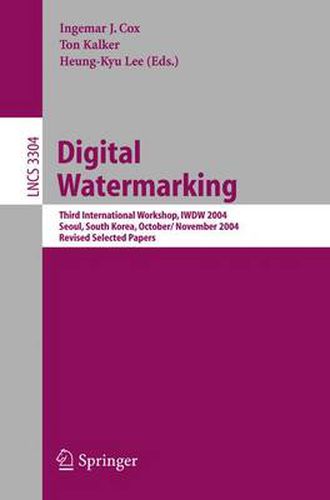Readings Newsletter
Become a Readings Member to make your shopping experience even easier.
Sign in or sign up for free!
You’re not far away from qualifying for FREE standard shipping within Australia
You’ve qualified for FREE standard shipping within Australia
The cart is loading…






This title is printed to order. This book may have been self-published. If so, we cannot guarantee the quality of the content. In the main most books will have gone through the editing process however some may not. We therefore suggest that you be aware of this before ordering this book. If in doubt check either the author or publisher’s details as we are unable to accept any returns unless they are faulty. Please contact us if you have any questions.
We are happy to present to you the proceedings of the 3rd International Workshop on Digital Watermarking, IWDW 2004. Since its modern reappearance in the academic community in the early 1990s, great progress has been made in understanding both the capabilities and the weaknesses of digital watermarking. On the theoretical side, we all are now well aware of the fact that digital watermarking is best viewed as a form of communication using side information. In the case of digital watermarking the side information in question is the document to be watermarked. This insight has led to a better understanding of the limits of the capacity and robustness of digital watermarking algorithms. It has also led to new and improved watermarking algorithms, both in terms of capacity and imperceptibility. Similarly, the role of human perception, and models thereof, has been greatly enhanced in the study and design of digital watermarking algorithms and systems. On the practical side, applications of watermarking are not yet abundant. The original euphoria on the role of digital watermarking in copy protection and copyright protection has not resulted in widespread use in practical systems. With hindsight, a number of reasons can be given for this lack of practical applications.
$9.00 standard shipping within Australia
FREE standard shipping within Australia for orders over $100.00
Express & International shipping calculated at checkout
This title is printed to order. This book may have been self-published. If so, we cannot guarantee the quality of the content. In the main most books will have gone through the editing process however some may not. We therefore suggest that you be aware of this before ordering this book. If in doubt check either the author or publisher’s details as we are unable to accept any returns unless they are faulty. Please contact us if you have any questions.
We are happy to present to you the proceedings of the 3rd International Workshop on Digital Watermarking, IWDW 2004. Since its modern reappearance in the academic community in the early 1990s, great progress has been made in understanding both the capabilities and the weaknesses of digital watermarking. On the theoretical side, we all are now well aware of the fact that digital watermarking is best viewed as a form of communication using side information. In the case of digital watermarking the side information in question is the document to be watermarked. This insight has led to a better understanding of the limits of the capacity and robustness of digital watermarking algorithms. It has also led to new and improved watermarking algorithms, both in terms of capacity and imperceptibility. Similarly, the role of human perception, and models thereof, has been greatly enhanced in the study and design of digital watermarking algorithms and systems. On the practical side, applications of watermarking are not yet abundant. The original euphoria on the role of digital watermarking in copy protection and copyright protection has not resulted in widespread use in practical systems. With hindsight, a number of reasons can be given for this lack of practical applications.